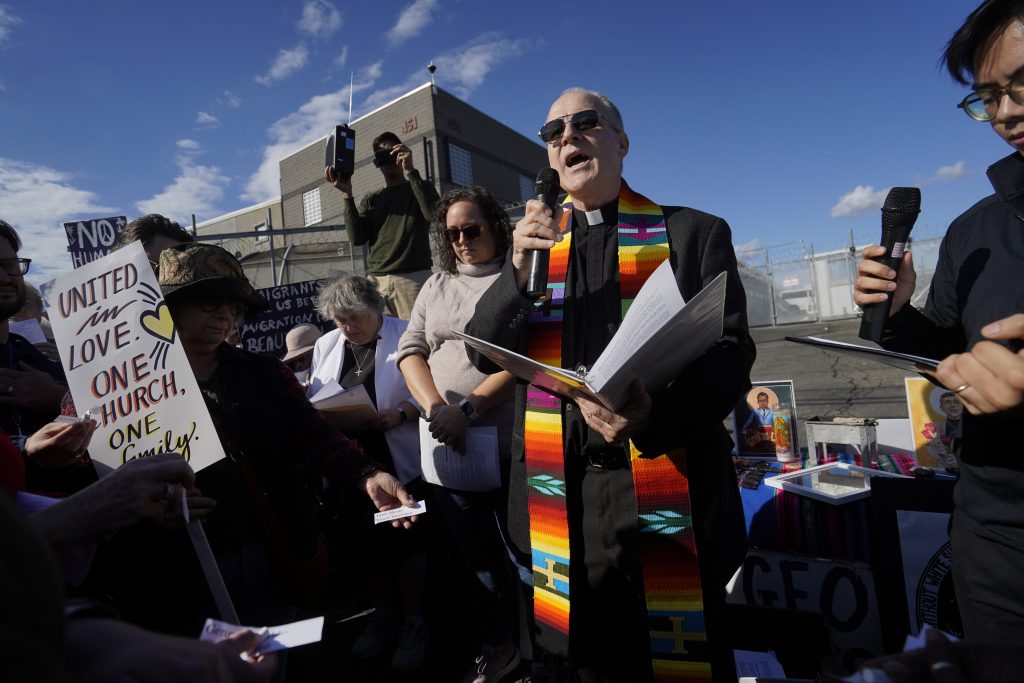Across the United States, Catholic organizations came together on October 22 for a national day of prayer and public witness in support of immigrants. The event, titled “One Church, One Family: Catholic Public Witness for Immigrants,” took place outside several U.S. Immigration and Customs Enforcement (ICE) offices, including in Washington, D.C. It was organized as a peaceful act of faith to call attention to the struggles faced by immigrant families under the Trump administration’s renewed immigration policies.
The vigils were organized by a coalition of Catholic groups, including Jesuits West Province, Jesuit Refugee Service USA, the Ignatian Solidarity Network, Maryknoll, Pax Christi USA, Network Lobby for Catholic Social Justice, and the U.S. Conference of Catholic Bishops’ Migration and Refugee Services. Several religious orders and Catholic communities also joined the effort, showing unity across different states.
In Washington, D.C., the prayer vigil was held in front of the ICE headquarters as employees entered the building during the morning rush hour. Some drivers honked in support as the group prayed and sang hymns. Judy Coode, communications director for Pax Christi USA, said the event was about “bearing witness to injustice” and reminding leaders to act with compassion. “We have a responsibility as Catholics and U.S. citizens to stand for justice,” she said. “Prayer is our way of calling on conscience and asking for a better way forward.”
The vigils were organized partly in response to the Trump administration’s rollback of a policy that had previously limited immigration enforcement in sensitive areas such as churches, schools, and hospitals. Many faith leaders fear that this change will discourage immigrants from attending worship or seeking help in these community spaces.
The Department of Homeland Security (DHS), which oversees ICE, defended the policy change, saying its agents act responsibly and require supervisory approval before taking action in places like churches. ICE Director Todd Lyons insisted that houses of worship are not being targeted. However, reports earlier this month of ICE activity near St. Jerome Catholic Church in Chicago raised fears among parishioners, though ICE later denied targeting the church.
Catholic leaders, including the U.S. bishops, have criticized the rollback, calling it inconsistent with the church’s moral teaching. The bishops filed an amicus brief in support of a lawsuit challenging the new policy, arguing that immigration enforcement should respect sacred spaces. Art Laffin, a member of the Dorothy Day Catholic Worker House, said during the vigil, “The church is a sanctuary and a refuge. To conduct immigration raids in such places would be a terrible injustice.”
Catholic teaching on migration emphasizes three key principles — the right of people to migrate for a better life, the right of nations to protect their borders, and the duty to balance these rights with justice and mercy. Sister Bethany Welch, a Sister of St. Joseph and part of the national planning team for “One Church, One Family,” said it is vital for Catholics to stand with detained immigrants. “Our faith calls us to be attentive to those who are being harmed or marginalized,” she said.
Sister Welch also participated in a binational pilgrimage earlier this month led by Bishop Gerald Kicanas of the Diocese of Tucson, Arizona. The pilgrimage symbolized unity across borders and reinforced the Catholic commitment to support migrants through prayer and public action. The next nationwide vigil will take place on November 13, the feast day of St. Frances Xavier Cabrini, known as the patron saint of immigrants.
Through these prayer vigils, the Catholic community hopes to remind Americans that compassion, faith, and justice must guide immigration policy. As many participants said, standing together in prayer is both a moral duty and a message of hope for all who seek safety and dignity.

